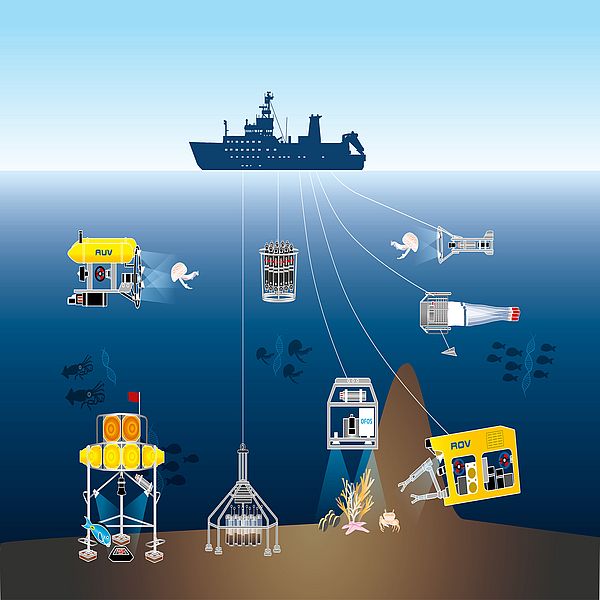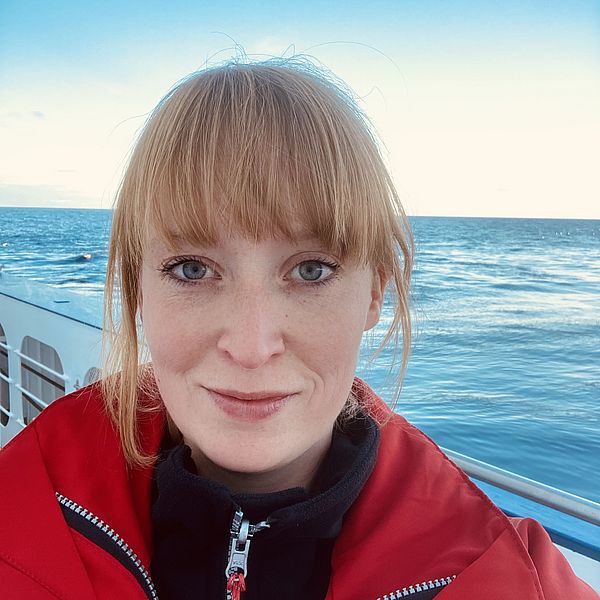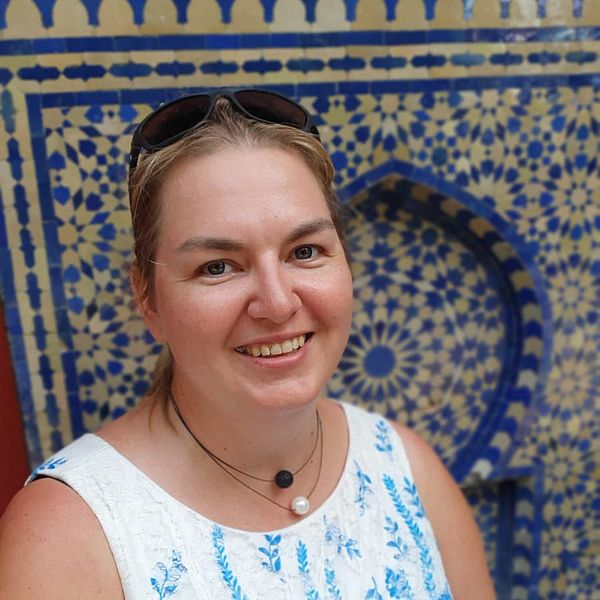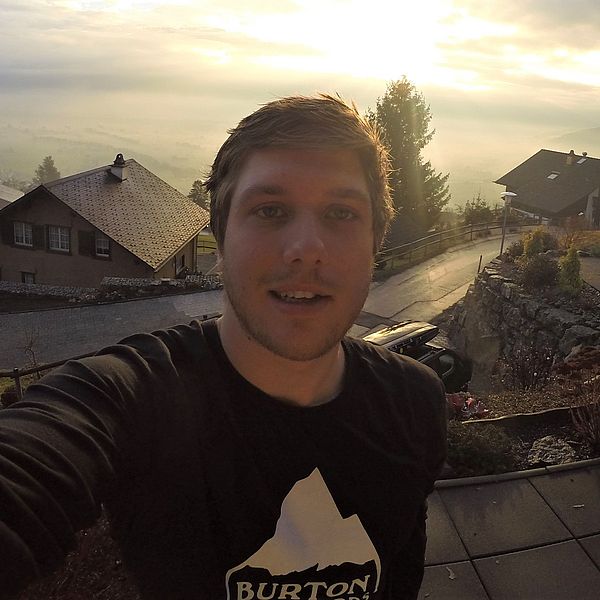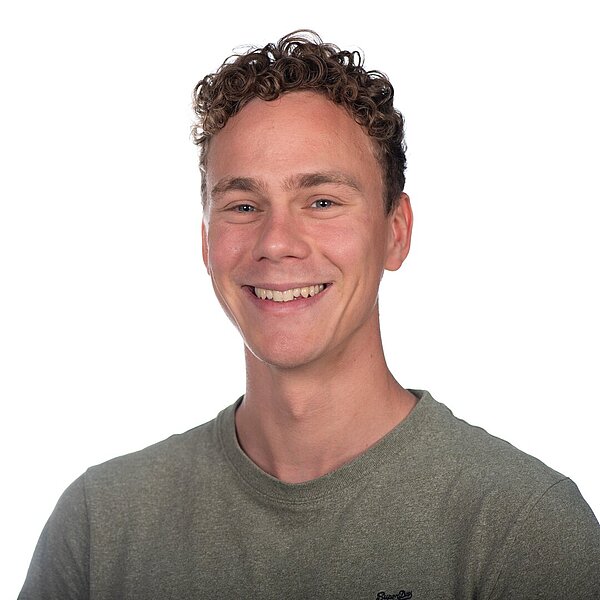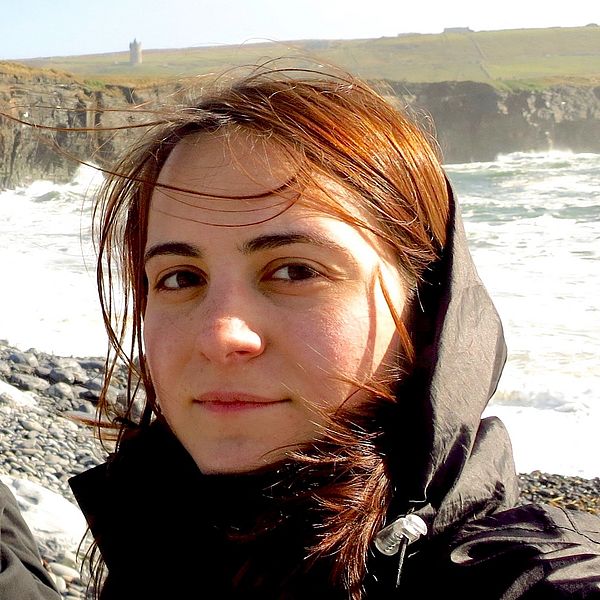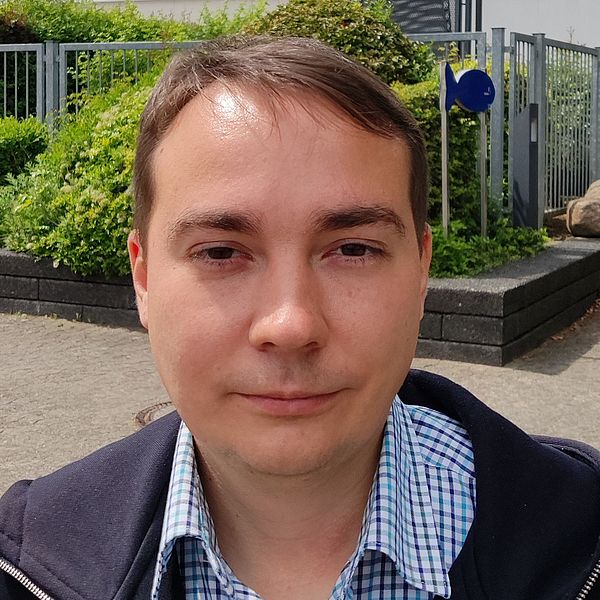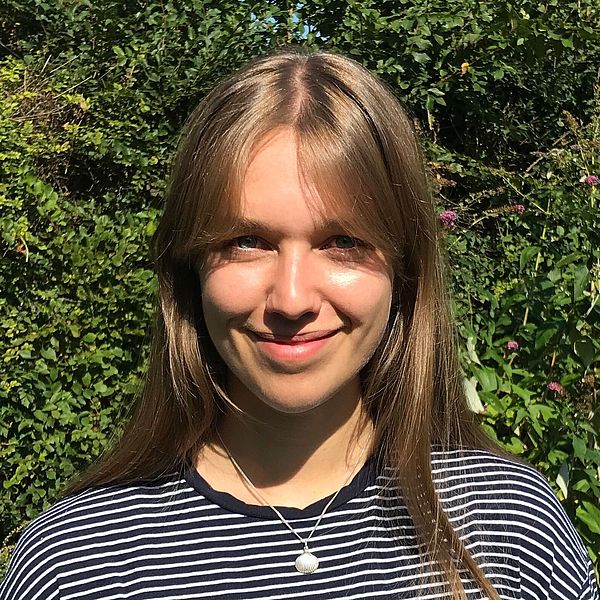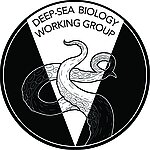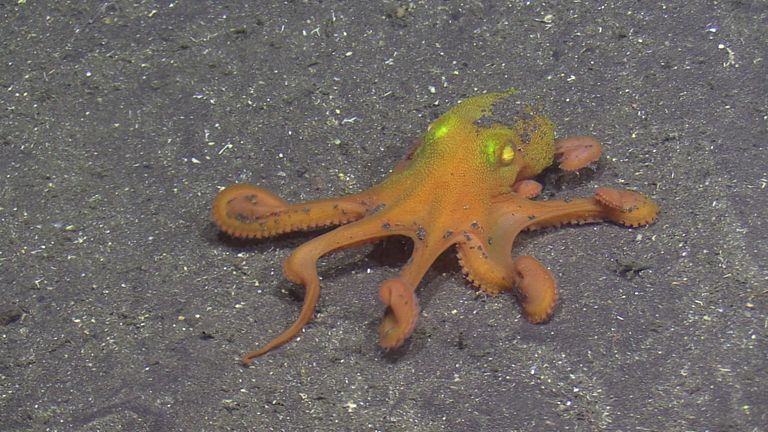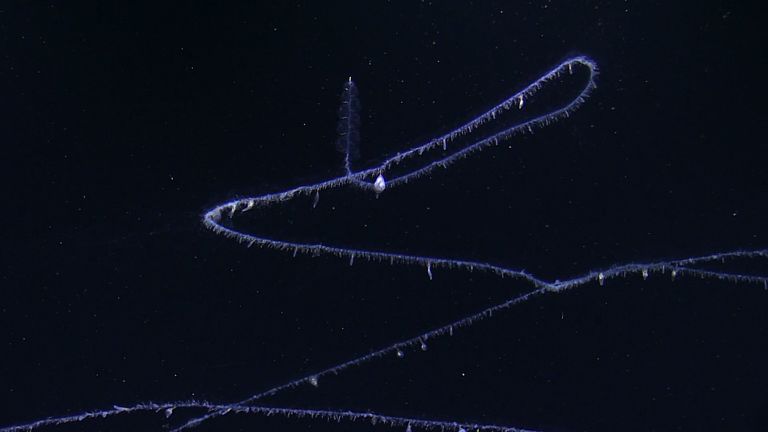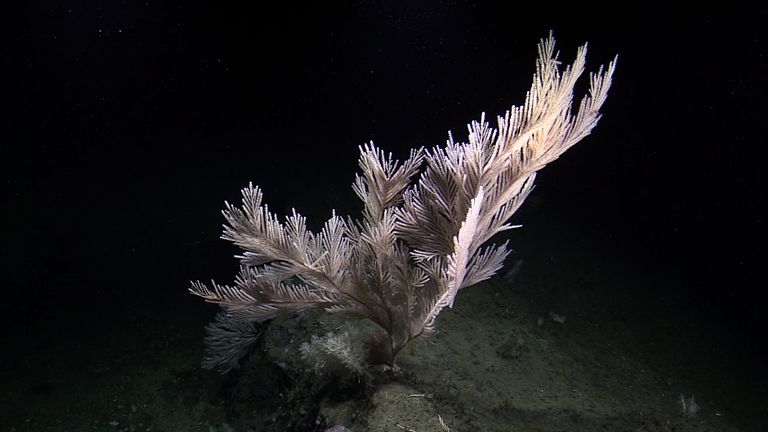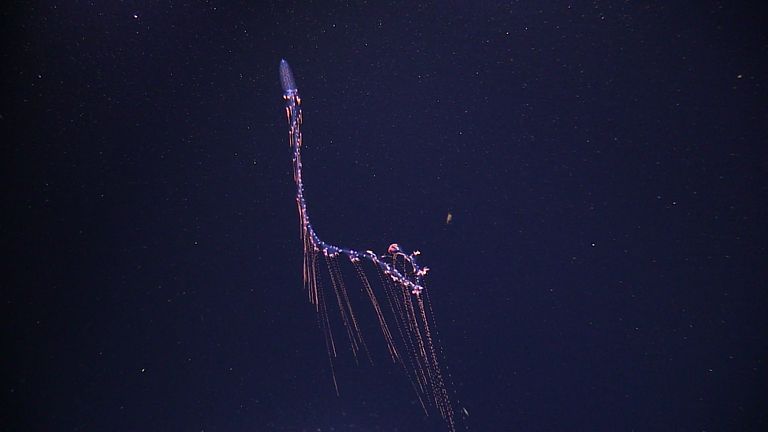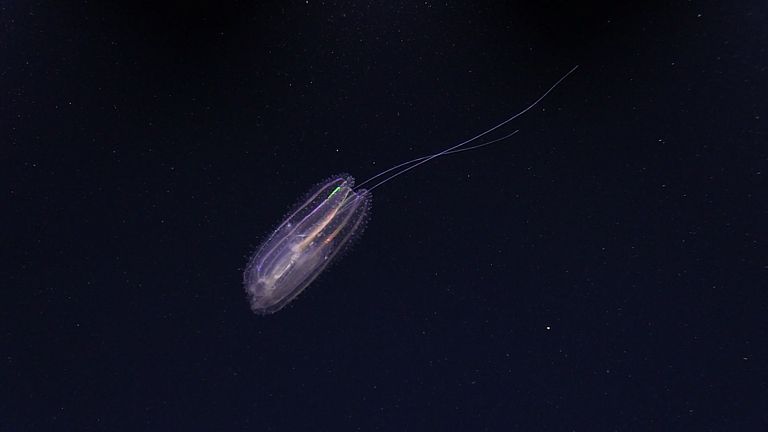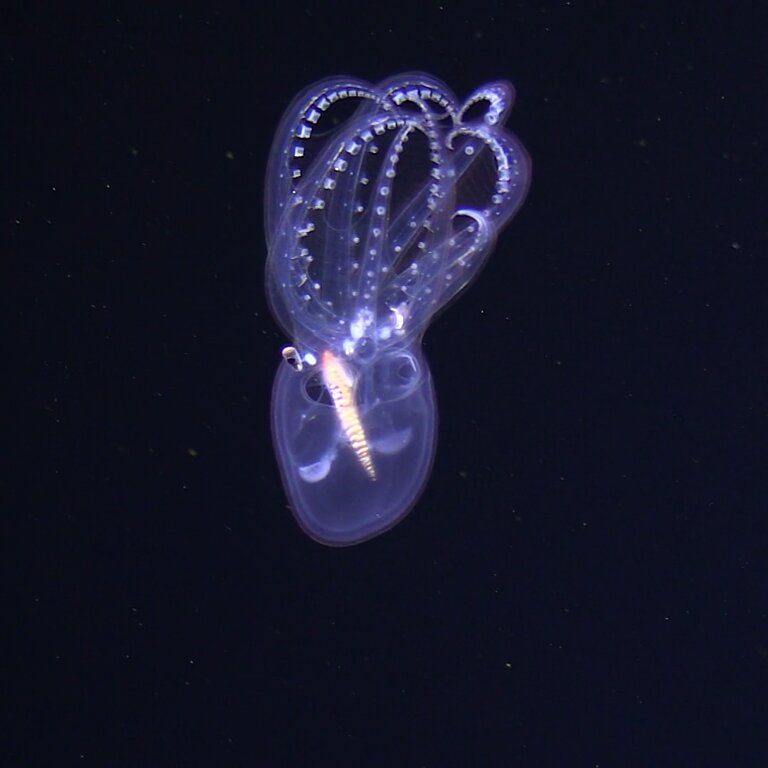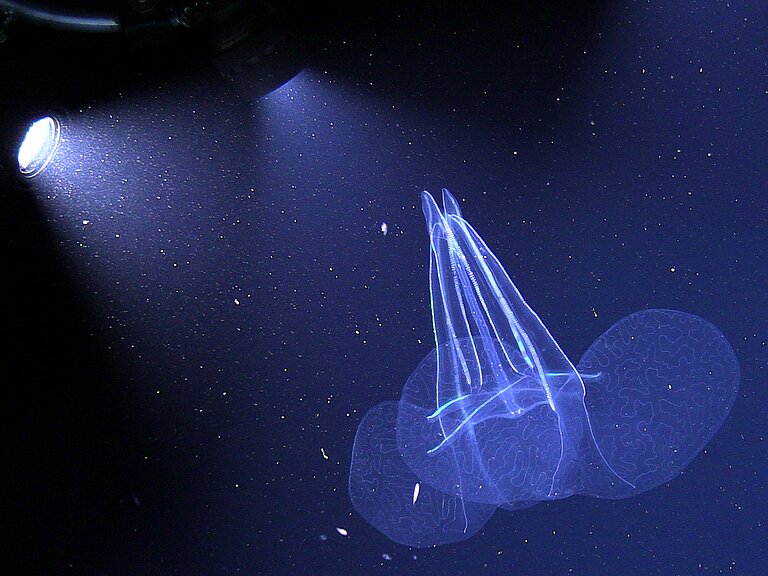Forschungsgruppe Deep-Sea Biology
Unsere Projekte
Unsere Forschungsgruppe beschäftigt sich mit Wachstum, Fortpflanzung, Biodiversität und der Nahrungsnetzökologie von Tiefseeorganismen, im Speziellen Cephalopoda (Kopffüßer) und gelatinösem Zooplankton.
Um einen besseren Einblick in Tiefseegemeinschaften zu bekommen führen wir Tiefsee-In-situ-Beobachtungen während Expeditionen im Atlantik, Pazifik und im arktischen Meer durch. Diese Observationen erfolgen mit Kamerasystemen die an verschiedensten Instrumenten, wie z.B. Tauchbooten oder so genannten freefall landers, befestigt sind, um Tiefseeorganismen in ihrer natürlichen Umgebung zu dokumentieren.
Wir analysieren pelagische Videotransekte, um Vorherzusagen treffen zu können, welche Arten regional zum Nahrungseintrag (engl. food falls) am Meeresboden beitragen und um die Vielfalt und Verteilung der Tiefseefauna zu visualisieren. Videoaufnahmen werden an Hand der Software VARS analysiert und in der Oceanic Biodiversity Observation Database (OBOD) gespeichert.
Um die Ablagerung natürlicher food falls zu quantifizieren, analysieren und erstellen wir Datenbanken von Aufnahmen des Meeresbodens und kalkulieren daraus den lokalen Kohlenstoffbeitrag.
Mit Hilfe experimenteller deep-sea landers, setzten wir Köder (Tintenfische, Quallen, ...) für einige Stunden am Meeresboden aus, um natürliche food falls in der Tiefsee nachzuahmen. Diese werden mit Foto- und Videoaufnahmen dokumentiert um die Verbrauchsrate und das Konsumverhalten der Aasfressergemeinschaften festzustellen.
In einem weiteren Projekt suchen wir mit Hilfe von environmental-DNA-Analysis nach Spuren pelagischer Organismen in der Tiefsee. Diese Technik ermöglicht, in Kombination mit Metabarcoding, den Nachweis verschiedenster Arten in Wasser- oder Sedimentproben.
Vorlesungen
Henk-Jan Hoving hält in verschiedenen Kursen des MSc program Biological Oceanography Vorlesungen und koordiniert die Übung Bioc-102 Biological oceanography.
Team
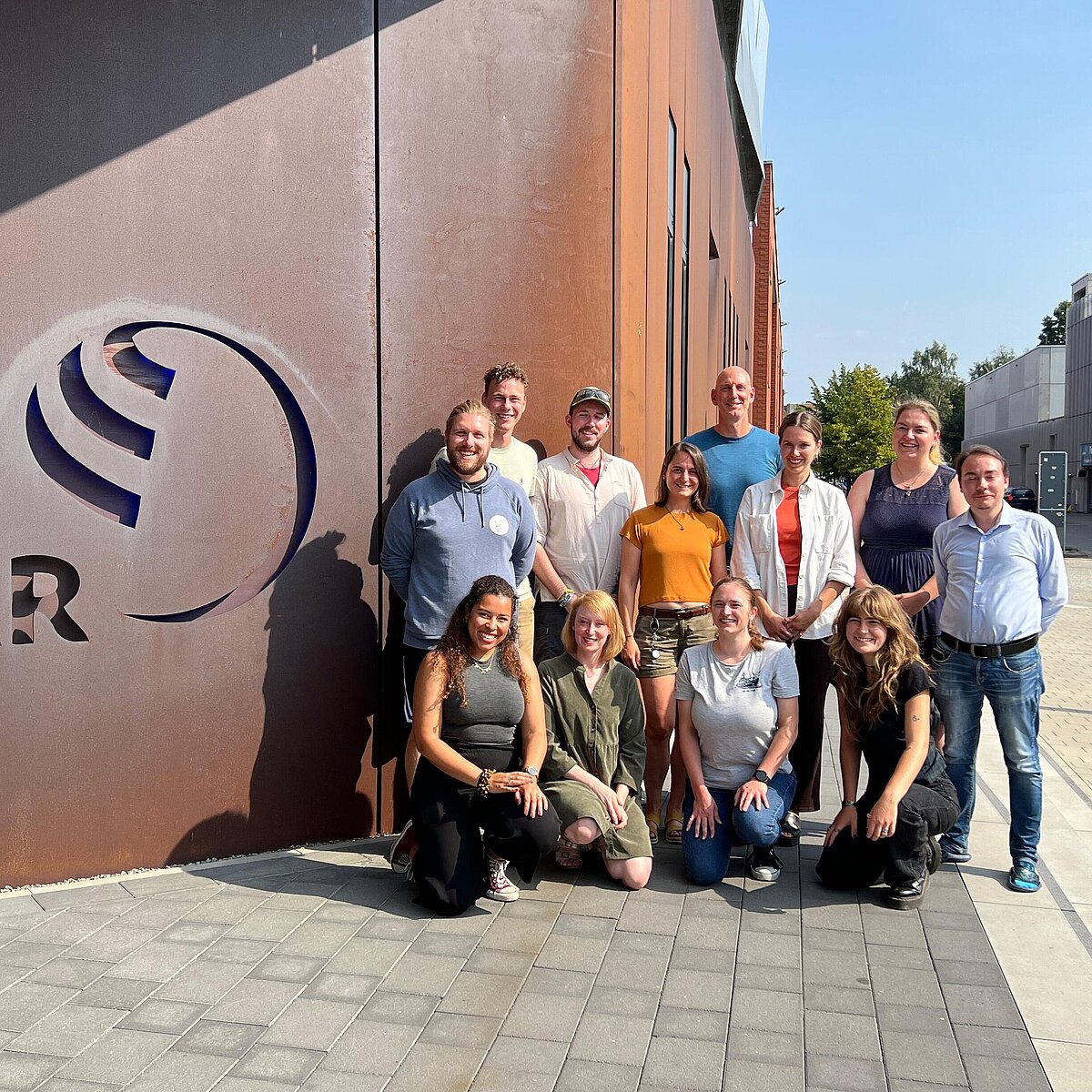
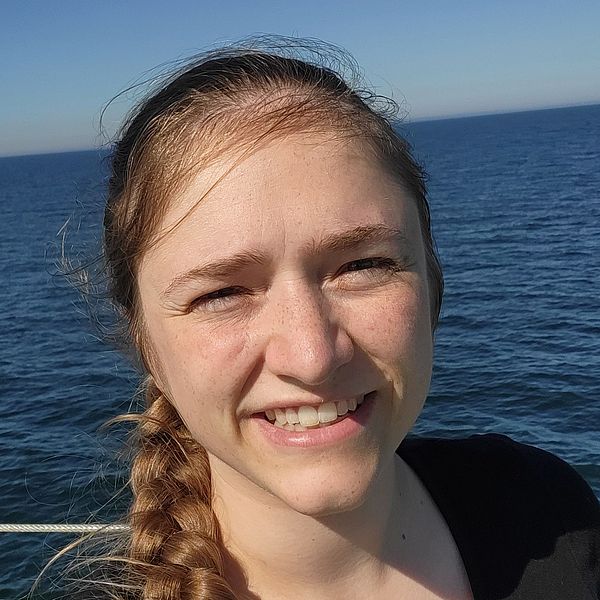
Ina Vornsand - MSc Studentin
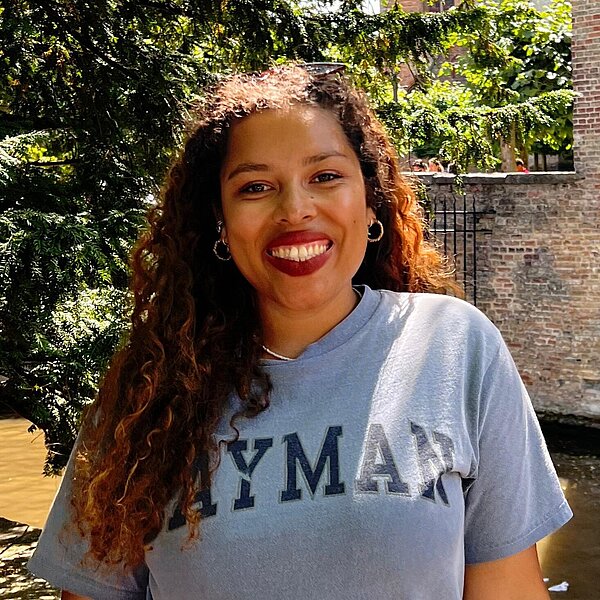
Samantha Schmidt - MSc Studentin
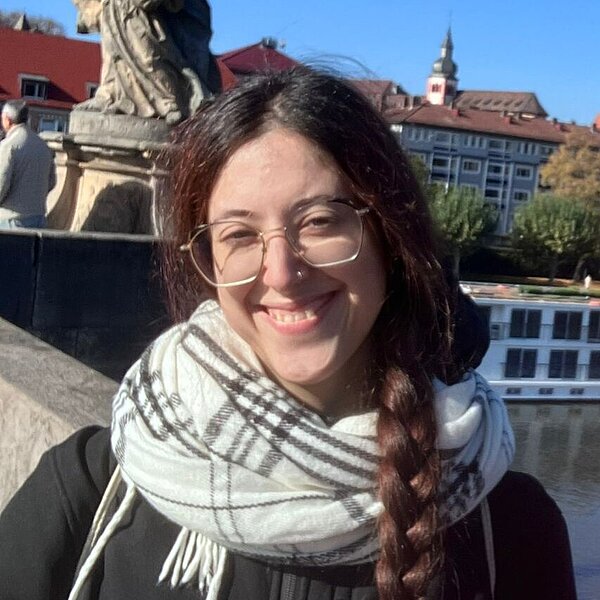
Sofia Modesti - MSc Studentin
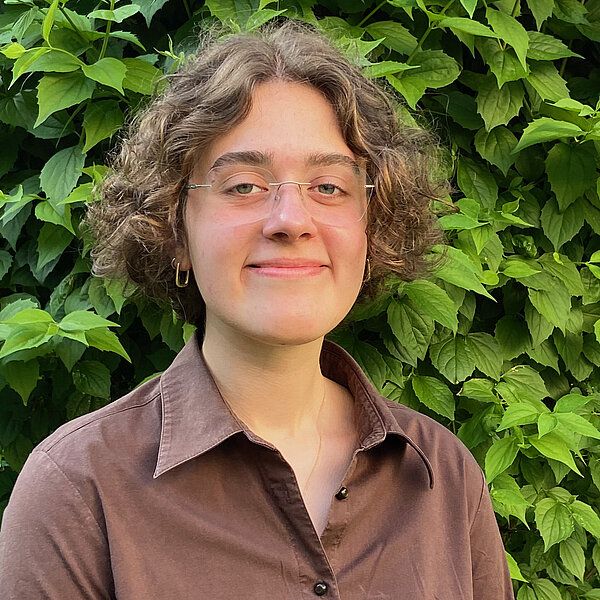
Clara Planitz - Praktikantin
Ehemalige Gruppenmitglieder
Megan Horsthuis
Dr. Miguel Guerreiro
Sophie Schindler
Kea Witting
Dr. Irina Chemshirova
Dr. Lara Schmittmann
Stella Scheer
Eva Rohlfer
Kim Heimberg
Philipp Neitzel
Dr. Richard Schwarz
Technologie und Entwickung
In Zusammenarbeit mit Ingenieuren des GEOMAR Technik- und Logistikzentrums (TLZ) haben wir das pelagische In-situ-Beobachtungssystem, kurz PELAGIOS, entwickelt. Pelagios ist ein Tiefseekamerasystem, das horizontale Videotransekte in der Tiefwassersäule filmt. Dieses System hat auch erfolgreich die vertikale Struktur von Tiefseegemeinschaften, sowie neue Arten und biogeochemische Funktionen der Tiefseefauna dokumentiert. Gemeinsam mit GEOMAR-Ingenieuren entwickeln wir laufend neue Wege, um Organismen in der Tiefsee zu erforschen und zu beproben.
Ausgewählte Expeditionen
2024 R/V Maria S. Merian MSM126, 26 days, Madeira. ROV PHOCA, Observational tools, nets, eDNA sampling multibeam mapping. Chief scientists: Dierking and Hoving
2024 R/V Meteor M202, 10 days, Azores, Observational tools, nets, eDNA sampling multibeam mapping. Chief scientists: Merten and Hoving
2023 R/V Heincke HE622 second leg, 8 days, North Sea, multibeam and towed side scan mapping, Chief Scientist Matthias Brenner
2022 R/V Heincke HE605, 28 days, Experiments stressors Themisto abyssorum for iAtlantic, Chief scientist Dr Henk-Jan Hoving & Charlotte Havermans
2022 R/V Pelagia PE507-508, 12 days, Deep-sea prey community and hunting whales, Chief scientist Dr. Fleur Visser & Dr. Susanne Wilken
2022 R/V Meteor M182, 41 days, Cabo Verde - Azores; MOSES/REEBUS Eddy Study III; Chief-Scientist: Prof. Dr. Jens Greinert
2021 R/V Heincke HE570, 17 days, Experiments stressors Periphylla periphylla for iAtlantic, Chief scientist Dr Helena Hauss & Dr Klas Ove Möller
2021 R/V Polarstern PS126, ancillary user project FRAMJELLY (Dr. C. Havermans, Dr. H.J.T. Hoving) investigating the role of gelatinous plankton in the Fram Strait using deep-sea landers, PELAGIOS, Multinet, CTD and eDNA collection. Chief Scientist Dr. K Metfies (AWI)
2020 R/V Pelagia PE479, 4 days, Deep-sea prey sampling with multi sensor mooring. Chief scientist Dr. F Visser
2020 R/V Maria S. Merian MSM95, 27 days, Arctic Seafloor Integrity ASI. Chief Scientist Dr. A Purser (AWI)
2019 R/V Western Flyer, 7 days MBARI Midwater Ecology Expedition Monterey Bay. Chief scientist Dr. BH Robison
2019 R/V Polarstern PS121, 35 days, ancillary user project CARCASS (Dr. H.J.T. Hoving) investigating the role of plankton and nekton in the biological carbon pump using deep-sea landers, PELAGIOS, Multinet, CTD and eDNA collection. Chief Scientist Dr. K Metfies (AWI)
2019 R/V Poseidon POS532, 21 days investigating the role of gelatinous zooplankton in the biological carbon pump in Cape Verde waters, manned submersible JAGO, PELAGIOS, Multinet, CTD and eDNA collection. Chief Scientist Dr. HJT Hoving
Ausgewählte Publikationen
Hoving HJT, F. Visser (2024) Whales and squid in a deep-sea arms race. Limnology and Oceanography Letters 9, 165–171 https://doi.org/10.1002/lol2.10391
Hoving HJT, Haddock S, Robison, BH, Seibel, B (2024) Giant eggs in a deep-sea squid. Ecology 105(7):e4319. https://doi.org/10.1002/ecy.4319
Golikov, A. V., Jørgensen, L. L., Sabirov, R. M., Zakharov, D. V., Hoving, H. J. (2024) Long-term annual trawl data show shifts in cephalopod community in the western Barents Sea during 18 years. Frontiers in Marine Science, Volume 11, Article 1392585. https://doi.org/10.3389/fmars.2024.1392585
Stenvers, V.I., Hauss, H., Bayer, T., Havermans, C., Hentschel, U., Schmittmann, L., Sweetman, A.K., Hoving, H.J.T. Experimental mining plumes and ocean warming trigger stress in a deep pelagic jellyfish. Nature Communications 14, 7352 (2023). https://doi.org/10.1038/s41467-023-43023-6
Golikov, A. V., Gudmundsson, G., Blicher, M. E., Jørgensen, L. L., Korneeva, E. I., Olafsdottir, S. H., Shagimardanova, E. I., Shigapova, L. H., Zakharov, D. V., Zimina, O. L., Sabirov, R. M. (2023) A review of the genus Muusoctopus (Cephalopoda: Octopoda) from Arctic waters. Zoological Letters, Volume 9, Article 21. https://doi.org/10.1186/s40851-023-00220-x
Guerreiro M.F., Borges F.O., Santos C.P., Xavier J.C., Hoving, H.-J. & Rui Rosa R. (2023) Impact of climate change on the distribution and habitat suitability of the world’s main commercial squids. Marine Biology, DOI: 10.1007/s00227-023-04261-w
Golikov A. V., Stauffer, J. B., Schindler, S. V., Taylor, J., Boehringer, L., Purser, A., Sabirov, R. M., Hoving, H.-J. (2023) Miles down for lunch: deep-sea in situ observations of Arctic finned octopods Cirroteuthis muelleri suggest pelagic–benthic feeding migration. Proceedings of the Royal Society B: Biological Sciences, Volume 290, Issue 2001. Art. 20230640. https://doi.org/10.1098/rspb.2023.0640
Merten, V.J., Puebla O., Bayer, T., Reusch T.B.H., Fuss J., Stefanschitz J., Metfies K., Stauffer J.B., Hoving H.J.T. (2023) Arctic nekton uncovered by eDNA metabarcoding: Diversity, potential range expansions, and pelagic-benthic coupling. Environmental DNA, Volume5, Issue3 (p. 503-518) https://doi.org/10.1002/edn3.403
Vlasova, E.V., Sabirov, R.M., Golikov, A.V. (2023) Reproductive biology of the golden cuttlefish Sepia esculenta (Cephalopoda, Sepiida). Diversity, Volume 15, Issue 3, Art. 455. https://doi.org/10.3390/d15030455
Golikov, A.V., Ceia, F.R., Hoving, H.J.T., Queirós, J.P., Sabirov, R.M., Blicher, M.E., Larionova, A.M., Walkusz, W., Zakharov, D.V., Xavier, J.C. (2022) Life history of the arctic squid Gonatus fabricii (Cephalopoda: Oegopsida) reconstructed by analysis of individual ontogenetic stable isotopic trajectories. Animals, V.olume 12, Issue 24, Art. 3548. https://doi.org/10.3390/ani12243548
Stauffer J.B., Purser A., Griffiths H.J., Smith C.R., Hoving H.J.T. (2022) Food falls in the deep northwestern Weddell Sea. Front. Mar. Sci., Sec. Deep-Sea Environments and Ecology
Volume 9 - 2022 | https://doi.org/10.3389/fmars.2022.1055318
Xavier, J.C., Golikov, A.V., Queirós, J.P., Perales-Raya, C., Rosas-Luis, R., Abreu, J., Bello, G., Bustamante, P., Capaz, J.C., Dimkovikj, V.H., González, A.F., Guímaro, H., Guerra-Marrero, A., Gomes-Pereira, J.N., Kubodera, T., Laptikhovsky, V., Lefkaditou, E., Lishchenko, F., Luna, A., Liu, B., Pierce, G.J., Pissarra, V., Reveillac, E., Romanov, E.V., Rosa, R., Roscian, M., Rose-Mann, L., Rouget, I., Sánchez, P., Sánchez-Márquez, A., Seixas, S., Souquet, L., Varela, J., Vidal, E.A.G., Cherel Y. (2022) The significance of cephalopod beaks as a research tool: an update. Frontiers in Physiology, Volume 13, Art. 1038064. https://doi.org/10.3389/fphys.2022.1038064
Stenvers, V.I., Sherlock, R.E., Reisenbichler, K.R., & Robison, B.H. (2022) ROV observations reveal infection dynamics of gill parasites in midwater cephalopods. Scientific Reports, 12(1), 8282. https://doi.org/10.1038/s41598-022-11844-y
Burford B.P., Wild L.A., Schwarz R., Bowers A., Chenoweth E., Sreenivasan A., Elahi R., Gilly W.F., Heintz R.A., Field J.C., Hoving H.J.T., Straley J. & Denny M.W. (2022) Rapid range expansion of a marine ectotherm reveals the demographic and ecological consequences of short-term variability in seawater temperature and dissolved oxygen. American Naturalist https://doi.org/10.1086/718575
Scheer S.L., Sweetman A.K., Piatkowski U., Hoving H.J.T. (2022) Food fall-specific scavenging response to experimental medium-sized carcasses in the deep sea. Marine Ecology Progress Series https://doi.org/10.3354/meps13973
Stenvers, V.I., Gonzalez, B.C., Goetz, F.E., Hemmi, J.M., Jessop, A., Lin, C., Hoving, H.J.T., & Osborn, K.J. (2021) Extraordinary eyes reveal hidden diversity within the holopelagic genus Paraphronima (Amphipoda: Hyperiidea). Deep Sea Research Part I: Oceanographic Research Papers, 177, 103610. https://doi.org/10.1016/j.dsr.2021.103610
Merten, V., Bayer, T., Reusch, TBH., Puebla, O., Fuss, J., Stefanschitz, J., Lischka, A., Hauss, H., Neitzel, P., Piatkowski, U., Czudaj, S., Christiansen, B., Denda, A., Hoving, H.J.T. (2021) An Integrative Assessment Combining Deep-Sea Net Sampling, in situ Observations and Environmental DNA Analysis Identifies Cabo Verde as a Cephalopod Biodiversity Hotspot in the Atlantic Ocean. Frontiers in Marine Science https://doi.org/10.3389/fmars.2021.760108
Stenvers, V.I., Hauss, H., Osborn, K.J., Philipp Neitzel P., Merten V.J., Scheer S., Robison B.H., Freitas R., Hoving H.J.T. (2021) Distribution, associations and role in the biological carbon pump of Pyrosoma atlanticum (Tunicata, Thaliacea) off Cabo Verde, NE Atlantic. Scientific Reports https://doi.org/10.1038/s41598-021-88208-5
F. Visser*, V. J. Merten*, T. Bayer, M. G. Oudejans, D. S. W. de Jonge, O. Puebla, T. B. H. Reusch, J. Fuss, H.J.T. Hoving (2021) Deep-sea predator niche segregation revealed by combined cetacean biologging and eDNA analysis of cephalopod prey. Science Advances doi: 10.1126/sciadv.abf5908, https://advances.sciencemag.org/content/7/14/eabf5908. *equal contribution
Hoving, H.J.T., Neitzel, P., Hauss, H., Christiansen, S., Kiko, R., Robison, B.H., Silva, P, and Körtzinger, A. (2020) In situ observations show vertical community structure of pelagic fauna in the eastern tropical North Atlantic off Cape Verde. Scientific Reports 10:21798 doi.org/10.1038/s41598-020-78255-9
Lischka, A, Lacoue-Labarthe, T, Bustamante, P, Piatkowski, U, Hoving HJT. (2020) Trace elements in the boreoatlantic gonate squid (Gonatus fabricii) demonstrate its ecological key role in polar regions of the Atlantic Ocean. Environmental Pollution 256: 113389 https://doi.org/10.1016/j.envpol.2019.113389
Hoving, HJT, Christiansen, S, Fabrizius, E, Hauss, H, Kiko, R, Linke, P, Neitzel, P, Piatkowski, U. and Körtzinger, A. (2019) The Pelagic In situ Observation System (PELAGIOS) to reveal biodiversity, behavior and ecology of elusive oceanic fauna. Ocean Science 15 (5) 1327-1340 doi.org/10.5194/os-2018-131.
zurück zum Anfang


